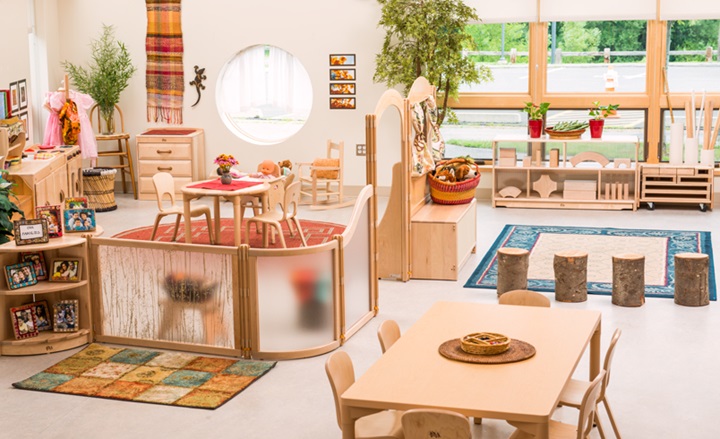The Pyramid Model
A framework to support social and emotional development in the early years
| July 2022Early years educators face numerous challenges in their day-to-day work with young children. Many teachers report that responding to children’s challenging behaviour is one of the most difficult and exhausting parts of their day. Teachers and other caregivers often share that they are not sure what to do to help young children when they are engaging in challenging behaviour, such as physical aggression, throwing materials and disrupting the learning of other children. In fact, many teachers cite challenging behaviour or classroom management as their number one training need. When challenging behaviour is persistent, teachers may feel overwhelmed, helpless, stressed and burned out. There are also consequences for young children who engage in persistent challenging behaviour; research has shown that there are higher rates of suspension and expulsion in early years settings than in primary and secondary school.
To address this need, a group of researchers developed the Pyramid Model to give early years educators and families a proactive framework for promoting positive behaviour and preventing challenging behaviour.
What is the Pyramid Model?
The Pyramid Model is a comprehensive, multi-tiered framework of evidence-based practices that promotes the social, emotional and behavioural development of young children. The emphasis of this framework is to support all children at the universal level, thereby decreasing the need for more intensive intervention. In fact, when implementing the Pyramid Model framework effectively, only a very small percent of children will need intensive intervention. The guiding principles of this model include promoting skill building with enough intensity to affect change, implementing strategies in the context of naturally occurring routines and environments, and modifying strategies so they are responsive to the cultural and linguistic diversity of families and children.

The Pyramid Model can be used in any setting that serves young children. Families should be partners in all tiers. The Pyramid Model is not a curriculum, but rather a framework to promote social-emotional development.
Foundation: Effective Workforce
The foundation of the Pyramid Model, or the base of the pyramid, acknowledges the need for an effective workforce. This means that we recognise the need for systemic support, and that well-defined policies and procedures are in place to ensure that the workforce can adopt and sustain the evidence-based practices that are part of the Pyramid Model. An effective workforce makes data-based decisions, develops strong partnerships with families and has strong administrative supports for the Pyramid Model’s positive, proactive philosophy of promotion, prevention and intervention.
Tier 1: Universal Supports
The first tier of the Pyramid Model is designed to be in place for all children and includes both nurturing and responsive relationships and high quality, supportive environments. With these universal supports for all children in place, 80% of challenging behaviour can be addressed!
Nurturing and Responsive Relationships
We know that nurturing and responsive relationships are essential for healthy social-emotional development. For the Pyramid Model, ‘relationships’ includes children, families and team members. For instance, it is important that caregivers develop positive relationships with the children in their care, with their colleagues and with the families they serve.
It is crucial for all young children, including those with the most persistent challenging behaviour, to have access to positive, supportive relationships with their caregivers and peers. Realising that all early years educators interact with children, families and team members daily, it is important to consider how a relationship differs from an interaction, and how lasting emotional connections can be created as relationships develop. Teachers should reflect on ways to embed positive interactions with all the children in their care across daily routines, so that these healthy relationships develop. For example, during routines such as nappy changing, naptime and feeding, caregivers can talk, sing and play with infants and toddlers.

It is crucial for all children to have positive, supportive relationships with their caregivers and peers.
High-Quality Supportive Environment
The second component of the Pyramid Model’s first tier is a high-quality, supportive environment. This includes the physical design, environmental cues (such as visuals), schedules and routines, carefully planned transitions, promoting engagement, making adaptations and modifications so all children can participate, and keeping classroom rules simple and positive.
Early childhood environments should be structured so that all children can actively participate and succeed. The environment also can be intentionally planned so that social emotional skill development is promoted, and challenging behaviour is prevented. For example, caregivers can ensure that there are sufficient materials in play areas and that the materials match children’s interests.
There is reciprocity between building relationships and creating a high-quality, supportive environment. For instance, in the context of everyday routines such as arrival and departure time, teachers can embed opportunities to build relationships, such as asking children questions about their weekend activities and favourite movies or making connections during shared book reading. Likewise, in an infant/toddler room caregivers can develop unique greetings to help make separations from family members easier.

The environment needs to be intentionally planned to support development.
While the focus of this article is on Tier I universal supports, which can promote social emotional competence and prevent challenging behaviour, there are two other tiers in the model:
Tier 2:
The second tier focuses on targeted social emotional supports to foster further development of social skills, problem-solving, anger management and strategies to help children calm down.
Tier 3:
The third or top tier addresses intensive interventions for children with persistent challenging behaviour who need additional support beyond the other tiers.
Conclusion
The first and most important thing that early educators can do is to build positive relationships with every child, family and team member. Their focus should be on the promotion of positive social emotional skill development through teaching and the prevention of challenging behaviour. There are no quick fixes to addressing challenging behaviour; it takes time and effort to implement the multi-tiered systems of supports that make up the Pyramid Model. Teachers need to consider their role as facilitators of children’s learning and development, and evaluate their own expectations, biases, teaching practices and classroom environments. When we put universal supports and strategies in place, the need for more intensive interventions is reduced.
For more information, see these resources:
https://challengingbehavior.cbcs.usf.edu/index.html
Hemmeter, M L, Ostrosky, M M, & Fox, L (2021). Unpacking the Pyramid Model: A practical guide for preschool teachers. Paul H Brookes Publishing Co.








